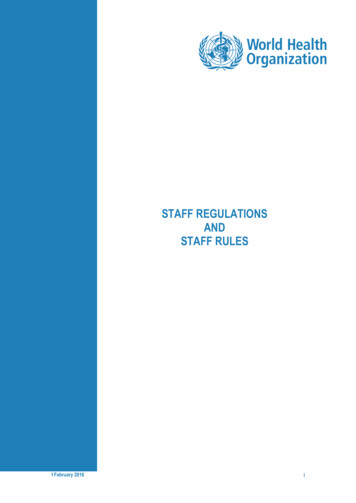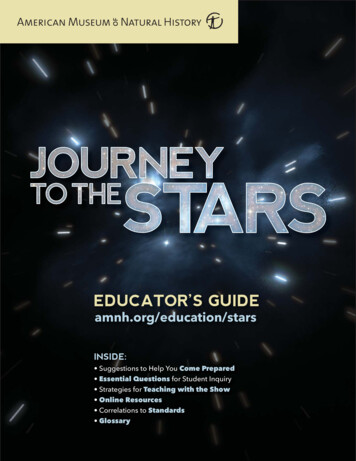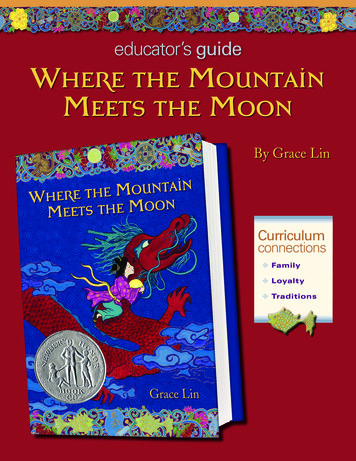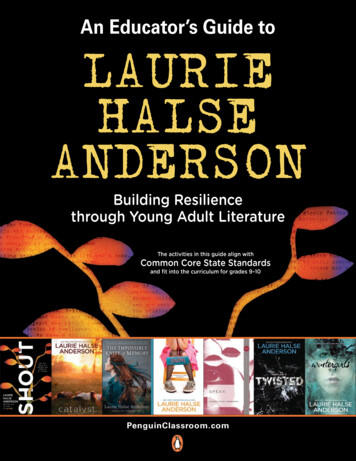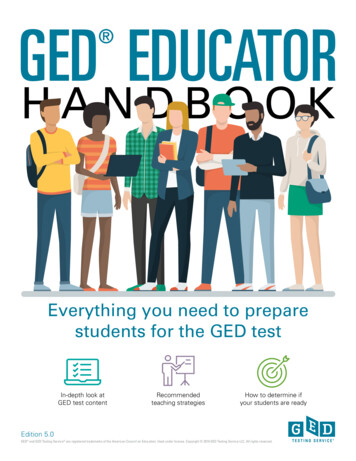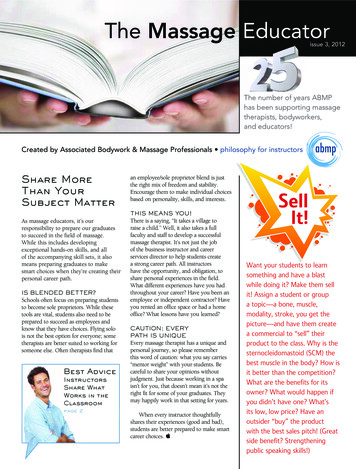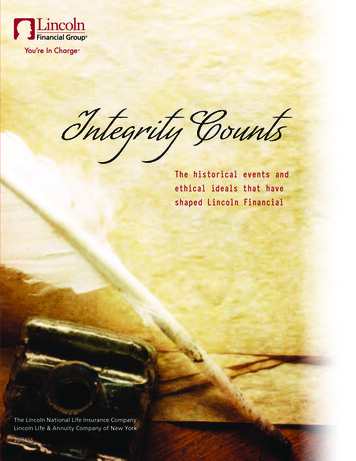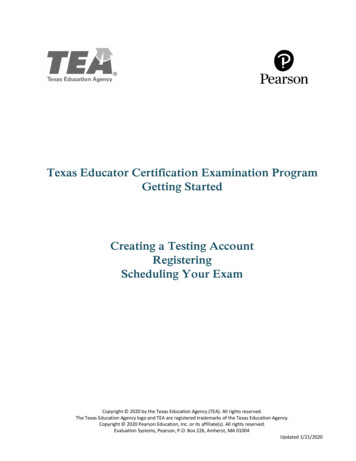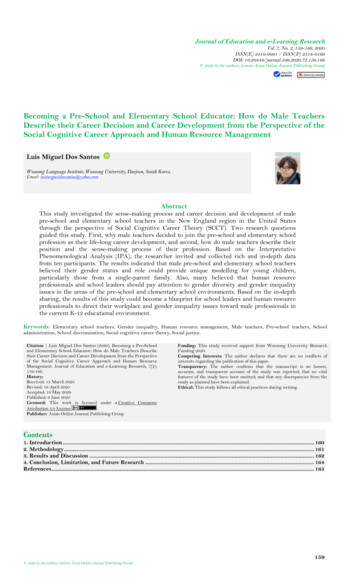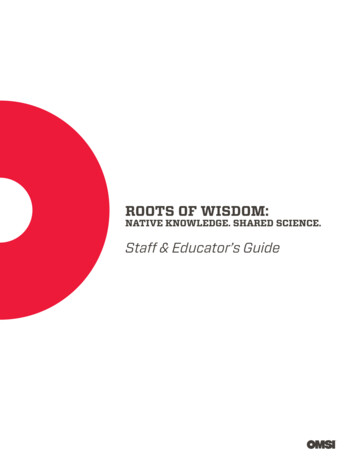
Transcription
Roots of Wisdom:NATIVE KNOWLEDGE. SHARED SCIENCE.Staff & Educator’s Guide
The graphic icon in the Roots of Wisdom logo expresses interconnection, a theme that is emphasizedthroughout the project in the content of the exhibition and activity kit, as well as the way all thepartners worked together. The four colors represent the four cultures featured in the project and areused throughout the exhibition and the website. As a jumping off point, we listed a few evocativewords—interconnection, reciprocity, kinship, collaboration—and selected several of the visual elementsused in the exhibition graphics—circles, the four colors, and dashed lines. The designer explored anumber of options, and we did a quick test with visitors to determine what they thought. Like every partof the project, we sought input from partners and advisors during the development of the icon.Funded by the National Science Foundation, Grant No. DRL-1010559. Any opinions, findings, andconclusions or recommendations expressed in this report are those of the authors and do notnecessarily reflect the views of the Foundation.ROOTS OF WISDOM: NATIVE KNOWLEDGE. SHARED SCIENCE. was developed by the Oregon Museum of Science and Industry (OMSI) incollaboration with the Indigenous Education Institute (IEI), the National Museum of the American Indian (NMAI), native community elders,educators, and youth. The exhibit was produced and is toured by the Oregon Museum of Science and Industry. The exhibit was made possiblewith funds provided by the National Science Foundation.
ContentsForward . 2Partners, Advisors, and Contributors. 4Introduction to Roots of Wisdom for Museum Staff . 7Guidelines for Respecting Cultural Knowledge. 8Speaking With and About Native People in the Museum . 14Important Considerations for Science Museums . 17Exhibition Overview . 19Goals of the Roots of Wisdom Exhibition . 20Exhibit Descriptions and Visitor Facilitation Tips . 20Correlation with Educational Standards . 25Active Learning Log . 28Active Learning Log Answer Key . 30Procedures and Daily Maintenance . 33Maintaining the Comment Board . 34Sample Floor Plan . 36References and Resources . 37Oregon Museum of Science and Industry1
ForwardThe Roots of Wisdom exhibition is rooted in indigenous knowledge and ways of life lived for countlessgenerations. Much of this Traditional Ecological Knowledge (TEK) has been passed down for generations.Today, as never before, this knowledge is of vital importance as it speaks strongly to the significance ofbalance to create a healthy environment. The exhibition also provides a contemporary scientificperspective, along with the traditional knowledge perspective, illuminating the complementary aspectsof both ways of knowing and a greater sense of understanding that would not be possible with oneperspective alone.The exhibition was created through a working partnership between a large science center (OregonMuseum of Science and Industry, OMSI), a Native, non-profit indigenous organization (IndigenousEducation Institute, IEI), and four Native communities: Native Hawaiian members of the PacificAmerican Foundation and Waikalua Loko Fishpond Preservation Society, Tulalip Tribes, ConfederatedTribes of Umatilla, and Eastern Band of Cherokee Indians. The partnerships were unique in that theywere created at the very beginning of the project to engage Native voices as co-creators of theexhibition. This type of collaboration provided a unique organization and process of creating theexhibition collaboratively with mutual consensus. This work was indeed a learning process for theparticipants and resulted in an exhibition that reflected the voices of the communities and respected theways that the communities wanted their stories told. At the same time, the process acknowledged therigor and discipline of the scientific establishment.Roots of Wisdom supported four distinct Native communities in sharing their stories of revitalization andrestoration using their traditional knowledge in a contemporary perspective. The result is a synthesis ofTEK and Western scientific knowledge in a way that each one complements the other.There are many commonalities between the two worldviews, but there are also many distinctdifferences even among and within tribes. In this project, the communities were able to speak forthemselves, and the collaborative process allowed for unique and authentic voices to be heard ratherthan a collective generalized, simplistic approach.To our eyes, the importance of understanding ecology from a Native perspective may be the mostsignificant aspect of the exhibition. The interconnections of all things and the interdependencies of allrelationships need to be understood within this comprehensive context of restoration built ontraditional knowledge and practices.Restoration in this case implies an understanding of environmental balance created by nature.Conservation in terms of the environment can enable a community to achieve wellness and freedomfrom toxicity. In Native communities, balance is of primary importance. Understanding the concept ofbalance is a facet of living in accordance with the natural cycle. This concept permeates every aspect oflife, from the skies of the universe to every part of the land and oceans.Oregon Museum of Science and Industry2
This collaborative project has provided a place for authentic Native voices in a major science center.Bringing together two lenses and two perspectives of Native and Western science results in a synthesisof restoration and conservation, thus engaging Native communities as well as the scientific communityto the benefit of the general public.The Roots of Wisdom exhibition is unique and, to the best of our knowledge, an exhibition like this onehas seldom been created before. We are grateful to OMSI and the National Science Foundation, as wellas to all the partners, for funding and bringing this project to fruition, in a spirit of collaboration, as wellas respecting traditional cultural protocol and professionalism.There are many Native communities in the United States, and we have only focused on fourcommunities (Native Hawaiian, Confederated Tribes of Umatilla, Tulalip Tribes, and Eastern Band ofCherokee Indians) for this exhibition. Almost every tribe across the county is involved in one way oranother in these kinds of restoration projects. Wherever Roots of Wisdom is exhibited, local tribes maywell have restoration projects underway. These projects can also be showcased as an addition to theexhibition and for public outreach in order to provide relevance and be useful to local communities.Each Native community has established sustainable ecological relationships with the local environment.Many places have been historically altered, but there is great potential to restore the land and waters toa healthy environment. In this age, human health and community wellbeing are connected to the land. Ahealthy environment can ensure a healthy population via the establishment of a balanced ecologicalnetwork. A reciprocal relationship of land and water resources should be of vital interest to everyperson and every community. After all, we share this planet together.David H. Begay, Ph.D.Nancy C. Maryboy, Ph.D.Indigenous Education InstituteOregon Museum of Science and Industry3
Partners, Advisors, and ContributorsThank you very much to the following partners, advisors, and contributors for participating in the Rootsof Wisdom project and the development of this guide.(Contributors are presented in alphabetical order by last name.)David Begay, Ph.D. (Navajo)Co-Principal Investigator and key contact from project partner Indigenous Education Institute (IEI)Vice President IEIInez Bill (Tulalip/Lummi)Key contact from project partner Tulalip TribesRediscovery Coordinator, Hibulb Cultural Center and Natural History PreserveTessa Campbell (Tulalip)Key contact from project partner Tulalip TribesCurator of Collections, Hibulb Cultural Center and Natural History PreserveSusan Chavez Cameron, Ph.D. (Diné)Contributor and reviewer from National Museum of the American Indian (NMAI)NMAI Educational Specialist, NMAIAdjunct Professor at Argosy UniversityDavid CozzoKey contact from project partner Revitalization of Traditional Cherokee Artisan ResourcesProject Director, Revitalization of Traditional Cherokee Artisan ResourcesDeana Dartt, Ph.D. (Chumash)Contributor and reviewer from the Portland Art MuseumCurator of Native American Art, Portland Art MuseumJoanne Jones-RizziAdvisorDirector of Community Engagement, Science Museum of MinnesotaHerb Lee, Jr. (Hawaiian)Key contact from project partners Pacific American Foundation and the Waikalua Loko FishpondPreservation SocietyExecutive Director, Pacific American FoundationOregon Museum of Science and Industry4
VerlieAnn Malina-Wright, Ed.D. (Hawaiian)Key Contact from project partners Pacific American Foundation and the Waikalua Loko FishpondPreservation SocietyRetired, Executive Director, Continuing Ed Program, Kamehameha SchoolsRetired, Vice Principal, Kula Kaiapuni O Anuenue Hawaiian Language Immersion SchoolPast President National Indian Education AssociationDennis Martinez (O'odham/Chicano)AdvisorCo-Director, Takelma Intertribal Project (TIP) and Chair, Indigenous Peoples' Restoration Network (IPRN)Nancy Maryboy, Ph.D. (Cherokee/Navajo)Co-Principal Investigator and key contact from project partner IEIPresident and Chief Executive Officer, IEIMargaret MathewsonAdvisorChief Instructor, Ancient Arts Center and Instructor, Oregon State UniversityRandall Melton (Confederated Tribes of the Umatilla Indian Reservation, CTUIR)Key contact from project partner CTUIRCollection Curator, Tamástslikt Cultural InstituteCharles Menzies, Ph.D. (Tlingit/Gitxaała)AdvisorProfessor of Anthropology, University of British ColumbiaDarren Ranco, Ph.D. (Penobscot)AdvisorCoordinator of Native American Research, Associate Professor of Anthropology, University of MaineWenix Red Elk (CTUIR)Key contact from project partner CTUIRPublic Outreach & Education Specialist, CTUIR Education DepartmentJill SteinExternal EvaluatorPrincipal Researcher, Lifelong Learning Group (LLG)Ashley C. Teren, M.Ed. (Cherokee)Key contact from project partner IEIOregon Museum of Science and Industry5
Project Manager, IEIChristopher S. Teren (Cherokee)Key contact from project partner IEITechnical Advisor, IEIPhotographer, IEI and Teren PhotographyShelly Valdez, Ph.D. (Laguna Pueblo)External EvaluatorPresident, Native PathwaysTheodore WilliamsAdvisorAcademic Program Developer, Northwest Indian CollegePamela Woodis (Jicarilla Apache)Key contact from project partner NMAIResources Materials Manager, NMAIOregon Museum of Science and Industry6
Introduction to Roots of Wisdom for Museum StaffThis Staff Guide has been written for the staff working and volunteering in the Roots of Wisdomexhibition and the people training them. The guide includes cultural sensitivity information, exhibitdescriptions, demonstration ideas, maintenance and safety tips, and the Active Learning Log—an openended worksheet for students to fill out while exploring the exhibition.As museum staff hosting the Roots of Wisdom exhibition, it is important to understand some of thecritical history, misconceptions, and current realities of U.S. Native communities and peoples. Fewpeople in North America know much about Native communities and cultures, leading them tostereotype Native peoples in disrespectful and misguided ways. Similarly, many non-Native peoplebelieve that “Indians are all gone,” “ancient relics,” or “something from the past” and talk about Nativepeople, communities, and cultures in the past tense. However, as museums and visitors will see in thisexhibition (and hopefully elsewhere), Native people have overcome many challenges and are very muchalive.In fact, it is an exciting time in Indian Country. Native peoples today are working on thriving and culturalrevitalization. Many communities are also focused on restoring their local environments becauseenvironmental health and cultural preservation depend on one another. The National ScienceFoundation and Ecological Association of America are also looking to Native people to help restoreenvironments. Roots of Wisdom demonstrates how four Native communities in the United States areusing Traditional Ecological Knowledge along with Western science to restore their local environments.Roots of Wisdom is a cross-cultural collaboration among the Oregon Museum of Science and Industry(OMSI), the Indigenous Education Institute (IEI), the National Museum of the American Indian (NMAI),and the four Native partner communities highlighted in the exhibition including the Confederated Tribesof Umatilla, Eastern Band of Cherokee Indians, Pacific American Foundation and Waikalua LokoFishpond Preservation Society, and the Tulalip Tribes.Abundant thanks go to all of the project partners, advisors, community leaders, and youth advisoryboard members who worked together to create this project. Their willingness to share their insights,time, stories, and hopes for the future is the heart of this project and will touch visitors around thecountry.If you have any questions about the content of the staff guide, exhibition, or related materials, pleasecontact the OMSI Exhibition Tour Manager at 503.797.4659 so that we can help connect you with theright people to answer your questions.Oregon Museum of Science and Industry7
Guidelines for Respecting Cultural KnowledgeThe topics included here were identified and written in collaboration with Deana Dartt, Ph.D.(Chumash), project advisors, and project partners.This section is meant to be a general introduction for museum staff on how to better respect andpresent cultural knowledge and issues pertaining to Native peoples in the United States. By no meansdoes the following section encompass all of the ongoing and multifaceted matters related to the variedand diverse cultures of the indigenous peoples of North America and Hawaii. Instead, the content isintended to address some of the most important questions and issues that museum staff might comeacross or be asked about. We strongly encourage museum staff to learn more by accessing theresources listed at the end of the guide and by looking for educational resources created by Nativecommunities in their areas.Respecting Native culturesValuing and respecting diverse cultures is critical for museums of all types and particularly importantwhen hosting the Roots of Wisdom exhibition. Staff should be considerate of cultural differences andsimilarities that exist without equating value (right or wrong, good or bad) to these differences.Respecting people and cultures means recognizing that all individuals are unique and that the way theyinteract with their community and the larger world is affected by their language, beliefs, values, andpersonal experiences. Respecting cultures in this way also allows us to communicate and collaboratemore effectively with diverse communities, such as in the Roots of Wisdom exhibition.When hosting the Roots of Wisdom exhibition or conducting any project with Native communities, it iscritical to develop a basic understanding of the key issues impacting Native communities today andhistorically. This understanding is particularly important because of the long history of human rightsabuses Native communities have been subjected to and the lack of information most people have aboutcontemporary Native peoples. Below, we highlight historical notes and discussions of some of these keyissues that project partners and advisors wanted staff at host museums to be aware of.North America was not “wild” or “undiscovered” before Europeans arrived[“Native people often feel the term ‘wild’ is a pejorative term. From a Native perspective, it isthinking more about a natural order. There is no such thing as a wild river, it has an order, nature’sorder. The beauty has an order.” --David Begay, Ph.D. (Navajo/Diné), Vice President, IEIIn many Native American languages, there is no word for wild. Instead, nature is often understood as aninterconnected, organic system of which the indigenous people are a part. However, because Europeanexplorers and settlers did not understand these interconnections or natural systems, they called theOregon Museum of Science and Industry8
environments that they encountered in the Americas “wilderness.” Therefore, for many Native people,using the word “wild” diminishes the value of nature’s order and the long-term relationships indigenouscommunities have had with their homelands.Similarly, it is crucial to understand that the ancestorsof contemporary Native American people were theoriginal discoverers and inhabitants of North Americaand that they lived on this continent for thousands ofyears before Europeans arrived. Contact withEuropeans first occurred with the arrival of Westernexplorers and settlers in the fifteenth century whobrought with them devastating diseases that Nativepeoples had no immunity to, cultural conflict, anddisplacement on a mass scale. These disturbanceschanged the life-ways and futures of millions ofpeople, and Native communities today are stillrecovering from the near obliteration of theirpopulations and cultures.“European settlers who first arrived inthe ‘New World’ wanted to believe it wasjust that: new not only to them but to allhuman kind. With their diseasespreceding them, diminishing complexNative civilizations, Europeans readilyassumed that the Americas were, andalways have been, a barely populatedwilderness. This view, which justifiedhundreds of years of European land theftand mistreatment of Indians, has beenslow to die.” --Stephanie Batencourt,NMAI (quotation from the NMAI book DoAlthough Europeans perceived North America as empty space when they arrived, it was in factpopulated by tens of millions of people (Batencourt 27) from an enormous diversity of Native Americancommunities. The continent was a mosaic of sophisticated cultures with varying political systems,spiritual beliefs, languages, and forms of art. These cultures included rich knowledge of their local“When talking about a name for the exhibit ‘wild’ was a word that rubbed people the wrong way.Native peopl
The four colors represent the four cultures featured in the project and are used throughout the exhibition and the website. As a jumping off point, we listed a few evocative . Adjunct Professor at Argosy University . David Coz
